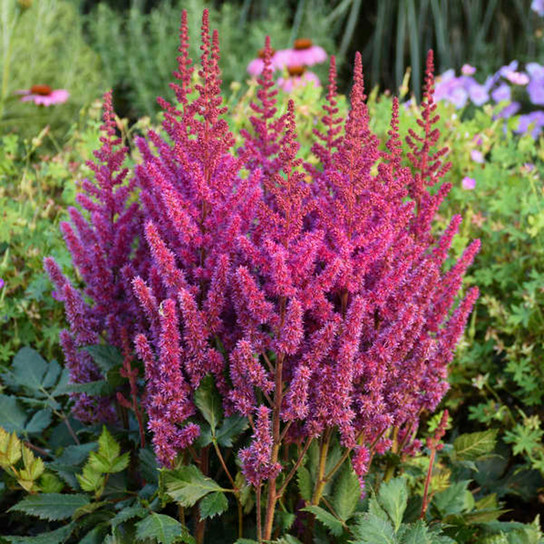
Astilbe
Uses:
- Shaded Borders
- Mass Planting
- Container Gardens
Features:
- Low Maintenance
- Pest Resistant
- Attracts Butterflies
Sunlight:
- Full Shade to Partial Sun
- Under 4 Hours of Direct Sun
- North Or East Side of Homes
Growing Zones:
- 3-9
- What is My Zone?
Astilbe is a perennial plant with beautiful, showy flowers atop glossy, fern-like foliage perfect for shaded areas. Give it consistent moisture and this easy to grow plant looks great even when not in bloom.
Why Buy Astilbe Online
Astilbe is a genus of 18 species of rhizomatous flowering plants within the family Saxifragaceae, native to mountain ravines and woodlands in Asia and North America. Astilbes, known by common names, False Goat’s Beard and False Spirea, are excellent for creating a soft, colorful display underneath trees, in low light corners, or in shady borders. Spirea plants are great because they are pest free and attract birds and butterflies. Blooms in purple, red, pink, and white with a soft blue green foliage color.
The Best Way to Use Astilbe
Astilbe works well with shrubs and other perennial plants. It does great under trees and is perfect to dress up an area of your yard such as near a compost pile or on the side of a fence or building. False Goat’s Beard is winter hardy in growing zones 3-9. Depending on the species, this plant ranges in height from 6 inches to 2 feet tall with a 6-inch to 5-foot spread. Astilbe prefers consistently moist soil and partial sun and shady conditions. It is a great plant to add color and texture to an area of your landscape where other flowers will not thrive.
Use in shaded areas
Adds texture to the garden
Available in purple, red, pink and white
Typically 6 inches to 2 feet tall
Growing zones 3 to 9
About Astilbe

False Spirea, Feather Flower, False Goat's Beard
Asia and North America, particularly woodland and shaded areas.
Perennials
Deciduous
4–9
Pink, white, red, lavender, purple, and peach.
Late spring to midsummer, with some varieties blooming into late summer.
Clump-forming, with feathery, plume-like flower spikes.
Bees and butterflies.
Partial to full shade and moist soil conditions.
Deer and rabbits.
How To Use Astilbe In The Garden
The biggest draw for Astilbes is their frothy plume-like flowers in shades of pink, red, white, and lavender. These dense flower clusters, composed of numerous tiny blossoms, rise above the plant's fern-like, deeply divided foliage. The foliage itself can be green, bronze, or burgundy, adding lushness and contrast to shaded garden areas. Astilbes are also appreciated for their ability to attract pollinators, such as bees and butterflies in spring to late summer.
Astilbes are wonderful for adding color and texture to shady areas, where many other flowering plants may not perform well. Astilbes are commonly used in borders, woodland gardens, and along streams or ponds, thanks to their preference for moist, well-drained soils. Their attractive foliage and striking flower plumes also make them suitable for mixed perennial beds, providing continuous interest throughout the growing season.
Astilbe Care
Astilbes require partial shade, ideally with morning sun and afternoon shade, to prevent leaf scorch. They thrive in loamy, well-drained soil that is acidic to neutral. Maintain consistent soil moisture by watering deeply when the top of the soil feels dry and applying mulch to retain moisture. At planting time and each spring, use a balanced slow-release fertilizer to support growth.
Pruning astilbes is generally unnecessary, as deadheading does not encourage additional blooms. However, removing yellowed leaves in the fall can enhance appearance, and leaving faded flowerheads adds winter interest. For winter care, especially in colder regions, apply mulch to protect the root system. When growing astilbes in containers, select pots with good drainage and keep the soil well-watered but not soggy. Divide plants every three to four years to maintain vigor.
Learn More About Astilbe

Astilbe Companion Plants
Astilbe prefers shaded areas and acidic soil along with consistent moisture. There are quite a few plants that can grow well next to astilbe with those same requirements that look fantastic together. Some of our favorites are azaleas, rhododendrons, hostas, and coral bells. Iris, coleus and impatiens also make great complements to astilbe.




























